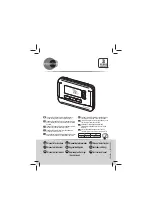
Omega Model CYD201/202 User’s Manual
2-8 Installation
2.4
SENSOR INSTALLATION RECOMMENDATIONS
Abbreviated sensor installation recommendations for the Model CYD201 are
included in this section. Please refer to the Omega Product Catalog for
sensor specifications. Call Omega for copies of application notes or with
questions or comments concerning sensor installation.
1. Do not ground the sensor.
2. Shield leads and connect shield wire to SHIELD on screw terminal
connector only. Do not connect shield at other end of cable.
3. Keep leads as short as possible.
4. Use twisted-pair wire. Use Omega Duo-Twist™ wire (or equivalent) for
two-wire, or Quad-Twist™ wire (or equivalent) for four-wire applications.
5. Thermally anchor lead wires.
2.4.1
Two-Lead Measurement Considerations
In two-lead measurement, the leads measuring sensor voltage are also the
current carrying leads. The resultant voltage measured at the instrument is
the sum of the temperature sensor voltage and the IR voltage drop within
the two current leads. In a cryogenic environment, the heat flow down the
leads is of critical concern, so wire of small diameter and significant
resistance per foot is preferred to minimize heat flow. Consequently, a
voltage drop within the leads may exist.
Expect some loss in accuracy since the voltage measured at the voltmeter
is the sum of the sensor voltage and the voltage drop across the connecting
leads. The exact measurement error depends on sensor sensitivity and
variations resulting from changing temperature. For example, a 10
Ω
lead
resistance results in a 0.1 mV voltage error. The resultant temperature error
at liquid helium temperature is only 3 mK, but because of the lower
sensitivity (dV/dT) of the diode at higher temperatures, it becomes 10 mK at
liquid nitrogen temperature.
2.4.2
Connecting Leads To The Sensor
Excessive heat flow through connecting leads to any temperature sensor
may differ the temperature between the active sensing element and the
sample to which the sensor mounts. This reflects as a real temperature
offset between what is measured and the true sample temperature.
Eliminate such temperature errors with proper selection and installation of
connecting leads.
To minimize heat flow through the leads, select leads of small diameter and
low thermal conductivity. Phosphor-bronze or Manganin wire is commonly
used in sizes 32 or 36 AWG. These wires have a fairly low thermal
conductivity, yet electrical resistance is not large enough to create
measurement problems.
Содержание CYD200 Series
Страница 1: ......
Страница 2: ......
Страница 22: ...Omega Model CYD201 202 User s Manual 2 14 Installation This Page Intentionally Left Blank ...
Страница 28: ...Omega Model CYD201 202 User s Manual 4 4 Service This Page Intentionally Left Blank ...
Страница 30: ...Omega Model CYD201 202 User s Manual A 2 Curve Table This Page Intentionally Left Blank ...
Страница 31: ......
Страница 32: ......
















































